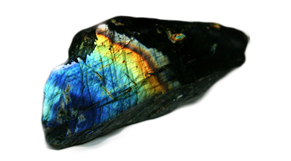

Stones That Play With Light
The rarest of all phenomena is color change. Read More

Labradorite, first found in 1770 off the coastline of Labrador, is a beauty in disguise . . .
More ...While I believe almost any gemstone is phenomenal, some gemstones show what the experts call "phenomena" - straight lines, asterisms, schiller, fluorescence, adularescence, labradorescence and others. The common element among all these "isms" is surprise. A relatively ordinary-looking stone is turned or a light is moved and... suddenly something unexpected jumps out at you. WOW!
Lines are among the easiest to find and to explain. Some stones that are single-color have a line of a different color running right down the middle. The line seems to move across the stone as the stone is turned relative to the light source.
A line inside a stone is actually an oriented inclusion. The included material deals with light differently from the stone, hence we see a different color. Lines are often referred to as "cats' eyes" - and some of them even seem to "blink" at you. Pretty strange. But fascinating.
"Stars" (asterisms) are better known (and more frequently imitated) than single lines, but they are really a similar phenomenon. In these, the included mineral is generally rutile, the same material found in some quartzes. In corundums - rubies and sapphires - the rultile forms a six-legged star that centers at the top of the stone and has roughly equal width "legs", each of which reaches to the bottom of the cabochon-cut stone. In diopsides, there are only four "legs". Other "star" stones are equally rare.
Many of the other phenomena are due to the layering of the included material at an angle to the outside of the stone. Labradorite and moonstone look like gray and white stones, respectively. When they move... Surprise! There are brilliant shades of blues under the outside gray or white! No matter how often you see it, there's always surprise.
The really amazing thing about the "lined" stones is that the person who cut and polished the stone had to have seen the inclusion and had to create the shape of the (cabochon) stone to maximize the effect. (I'd sure hate to be the person who wrecked a rare, natural star sapphire by not getting the star in the right place...)
The rarest of all phenomena is color change. Many stones seem to shift a bit in color as you look at them from different angles. True color-change gems (alexandrite, garnet, etc.) actually react to the different colors of the kind of light in which you see them. Alexandrite, for example, looks like an "emerald by day" (green) and a "ruby by night" (pink/red). The change is instantaneous - as soon as you walk outside or inside. The intensity of the change has to do with the mix of elements inside the stone. Degree of color change is subjective, but greatly affects value. If anyone ever offers you a decent-sized alexandrite for a price we could afford, have the thing tested by an expert before you even think about buying.
© 2016 Simple Elegance LLC
web development by turbocatalyst